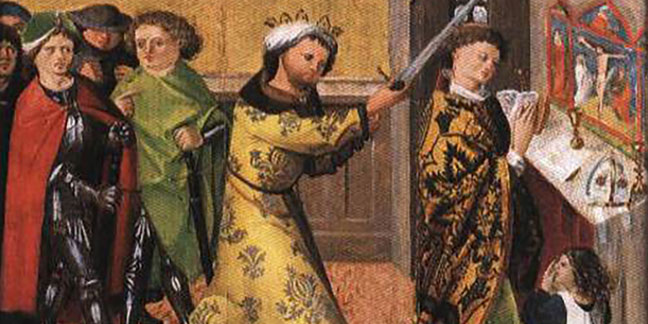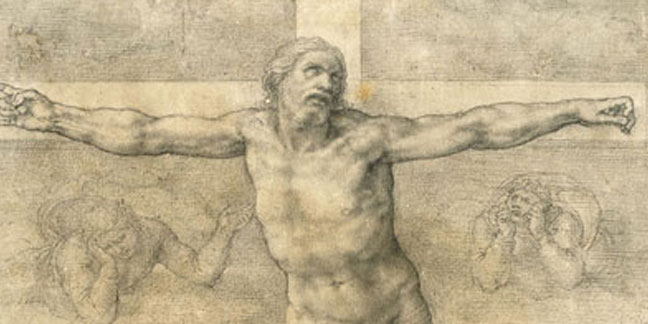 On April 11, the Catholic Church honors the memory of the 11th-century bishop and martyr St. Stanislaus of Krakow, who died for the faith at the hands of King Boleslaus II.
On April 11, the Catholic Church honors the memory of the 11th-century bishop and martyr St. Stanislaus of Krakow, who died for the faith at the hands of King Boleslaus II.
Canonized in 1253, St. Stanislaus is a beloved patron of Poland and one of the earliest native Polish bishops. In his own country he is commemorated on May 8. (The exact date of his death is uncertain. According to different sources, it was either April 11 or May 8, 1079.)
St. John Paul II – who was Kraków’s archbishop in the “See of St. Stanislaus” before becoming pope – paid tribute to him often during his pontificate. In a 2003 letter to the Polish Church, he recalled how St. Stanislaus “proclaimed faith in God to our ancestors and started in them...the saving power of the Passion and Resurrection of Jesus Christ.”
“He taught the moral order in the family based on sacramental marriage. He taught the moral order within the State, reminding even the king that in his actions he should keep in mind the unchanging Law of God.” Through St. Stanislaus, God taught the Polish pope’s homeland to respect “the Law of God and the just rights of every person.”
Born near Kraków in July of 1030, Stanislaus Szczepanowski was the son of Belislaus and Bogna. His parents, members of the nobility, showed great zeal and charity in their practice of the Catholic faith. Their son studied for a time in his own country, and went on to learn theology and canon law in Paris. The death of his parents left him with a large inheritance, which he gave away to the poor.
After his ordination to the priesthood, Stanislaus served the Church in Kraków in different pastoral and administrative posts. Following the death of the diocese’s leader, Bishop Lambert Zula, Stanislaus was chosen as his successor in 1071. He did not want the position, but obeyed Pope Alexander II’s direct order to accept it. Having done so, he proved to be a bold preacher of the Gospel.
This boldness brought him into conflict with Poland’s ruler, King Boleslaus II, who was becoming notorious for his violent and depraved lifestyle. After a series of disputes over his scandalous behavior and other matters, Stanislaus found no success in his efforts to reform the king.
He excommunicated the sovereign – who responded with furious anger, sending henchmen to kill the bishop while he was offering Mass in the Chapel of St. Michael, located in a suburb of Kraków. But the soldiers all came out, saying they had been frightened by a light from heaven. Boleslaus then took matters into his own hands, ambushing Stanislaus and striking him down with a sword at the altar.
St. Stanislaus was soon acclaimed as a martyr, while Boleslaus II was deposed and fled to Hungary. In later years the fallen monarch is said to have lived in a monastery, repenting of the murder.
— Catholic News Agency
Holy Week is the wee k which precedes the Resurrection on Easter Sunday. From the Church's earliest times, the week has been filled with commemorations of Jesus' triumphant entry into Jerusalem, His Passion, death and Resurrection.
k which precedes the Resurrection on Easter Sunday. From the Church's earliest times, the week has been filled with commemorations of Jesus' triumphant entry into Jerusalem, His Passion, death and Resurrection.
Palm Sunday
The sixth and last Sunday of Lent and beginning of Holy Week commemorates Jesus' entry into Jerusalem. The main ceremonies are the benediction of the palms, the procession, the Mass and the singing of the Passion.
The blessing of palms and the Palm Sunday procession date back to the earliest Church in Jerusalem. Palm branches have always been symbols of joy and victory, and in Christianity, as a sign of victory over the flesh and the world according to Psalm 91:13, "Justus ut palma florebit." The blessed palms are taken home by the faithful and used as a sacramental. Blessed palms are also burned to make ashes for the next year's Ash Wednesday.
Every great feast was in some way a remembrance of the resurrection of Christ and was called "Pascha." "Pascha" really comes from a Hebrew word meaning "passage" (of the destroying angel at Passover), but the Greeks took it to be identical with "paschein" ("to suffer"). From the custom of also blessing flowers and entwining them among the palms arose the term "Dominica Florida," or "Flower Sunday." One notable bit of trivia: Related terms are "Pascha floridum," or "Pascua florida" in Spanish – and it was from this Spanish term for Palm Sunday that Florida received its name on that day in 1512.
The Gospel of the Passion is also read during the Palm Sunday Mass. As on Good Friday, and on the Tuesday and the Wednesday of Holy Week, the Passion is sung by three deacons who impersonate respectively the Evangelist ("Chronista"), Jesus, and the other speakers ("Synagoga"). This division of the Passion among three characters is very ancient, and it is even indicated by rubrical notes in early manuscripts of the Gospel.
Holy (Maundy) Thursday
The oldest of the Holy Week observances, this day commemorates the institution of the Eucharist. Holy Thursday consists of a succession of joyful ceremonies: reconciliation of penitents, consecration of the holy oils (the "Missa chrismalis," or "Chrism Mass"), washing of the feet ("pedilavium"), and commemoration of the Eucharist.
"Maundy" derives from "Mandatum" (the first word of the Office of the Washing of the Feet). This marks the central rite of the day.
On that day Mass and Communion typically followed the evening meal. In the early Church in Rome, everything was carried on in daylight, whereas in Africa on Holy Thursday the Eucharist was celebrated after the evening meal, in view of more exact conformity with the circumstances of the Last Supper. This early tradition survives to the present time in that the clergy do not offer Mass privately but are directed to Communicate together at the public Mass, like guests at one table.
Also on Holy Thursday the ringing of bells ceases until the Easter Vigil, the altar is stripped, and candles remain unlit – outwardly demonstrating the sense of the Church's bereavement during the time of Christ's Passion and burial. The observance of silence during these three days dates at least from the eighth century.
Good Friday
This is the day of Christ's Passion, death and burial, now primarily celebrated by a service combining a number of features.
First are the reading of three sets of lessons followed by "bidding prayers." Secondly, there is the Adoration of the Cross. The dramatic unveiling and adoration of the Cross, introduced into the Latin Liturgy in the seventh or eighth century, originated in the Church in Jerusalem, where a relic of the True Cross was venerated.
In the "Peregrinatio Sylviæ," (written from 378 to 394), that early ceremony is described: "Then a chair is placed for the Bishop in Golgotha behind the Cross ... a table covered with a linen cloth is placed before him; the Deacons stand around the table, and a silver-gilt casket is brought in which is the wood of the holy Cross. The casket is opened and (the wood) is taken out, and both the wood of the Cross and the Title are placed upon the table. Now, when it has been put upon the table, the Bishop, as he sits, holds the extremities of the sacred wood firmly in his hands, while the Deacons who stand around guard it. It is guarded thus because the custom is that the people, both faithful and catechumens, come one by one and, bowing down at the table, kiss the sacred wood and pass on."
Holy Saturday
Holy Saturday is also known as Great (or Grand) Saturday, the Angelic Night, and the Easter Vigil. It is not like Maundy Thursday, a day of joy, but one of joy and sadness intermingled; it is the close of the penitential season of Lent, and the beginning of paschal time, which is one of rejoicing. Its essential feature is the baptism of the catechumens, who have been preparing during Lent to enter the Church.
The Easter Vigil opens with the blessing of the paschal fire and the lighting of lamps and the paschal candle. St. Cyril of Jerusalem said this night was as bright as day, and Emperor Constantine in Rome added unprecedented splendor with a profusion of lamps and enormous torches, so that not only churches, but houses, streets and squares were ablaze with light symbolic of the Risen Christ.
The Holy Saturday ceremony has lost much of the significance it enjoyed in the early Christian centuries, owing to the irresistible tendency to celebrate it earlier in the evening. Originally it was held only in the late hours of Saturday and barely ending before midnight. To this day, however, the brevity of the Easter Mass preserves a memorial of the fatigue of that "watch-night" that ended the austerities of Lent.
Finally, the Vigil Mass, with its joyous "Gloria," at which the bells are again rung, the uncovering of the veiled statues and pictures, and the triumphant "Alleluias," which mark nearly every step of the liturgy, proclaim the Resurrection of Our Lord Jesus Christ.
— Source: Catholic Encyclopedia, online at www.newadvent.org
Follow us online
At www.facebook.com/catholicnewsherald: Share your photos and comments about Lent, Holy Week and Easter
Pictured above: The Crucifixion by Michelangelo, a drawing in black chalk: Michelangelo made this devotional image for his friend Vittoria Colonna. An aristocratic poet and religious reformer, she became his confidante in the mid-1530s. Unusually, Michelangelo shows the Crucified Christ alive and suffering, at once human and divine. This imagery, as well as Michelangelo's late additions of the lamenting angels and a skull, may reflect Colonna's input into the design. Michelangelo was a devout Catholic and during the last three decades of his life, his faith deepened. This was partly inspired by Colonna as well as a growing sense of his own mortality. The Crucifixion was a subject which he returned to right at the end of his life in a series of three drawings. The potency of this earlier image inspired a number of painted and engraved versions. (Image provided by the British Museum)

